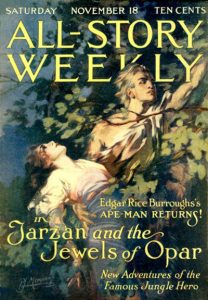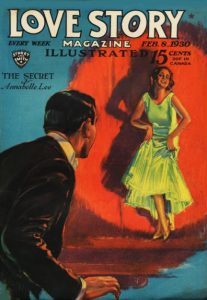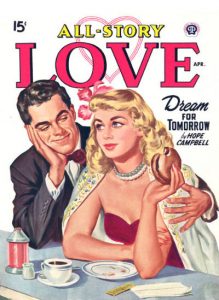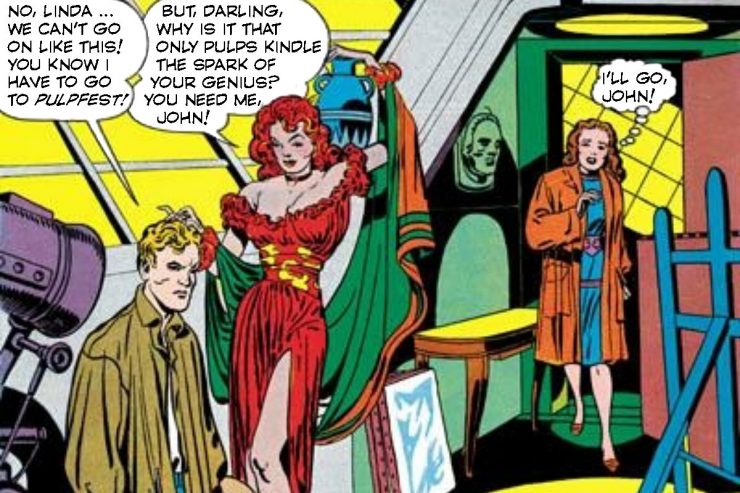 Love stories have been with us forever. Think JANE EYRE, PRIDE AND PREJUDICE, ROMEO AND JULIET, and even THE HUNCHBACK OF NOTRE DAME, THE PHANTOM OF THE OPERA, and TARZAN OF THE APES. From our own time, there’s OUTLANDER, THE PRINCESS BRIDE, TWILIGHT, and the love lives of Spider-Man and Superman.
Love stories have been with us forever. Think JANE EYRE, PRIDE AND PREJUDICE, ROMEO AND JULIET, and even THE HUNCHBACK OF NOTRE DAME, THE PHANTOM OF THE OPERA, and TARZAN OF THE APES. From our own time, there’s OUTLANDER, THE PRINCESS BRIDE, TWILIGHT, and the love lives of Spider-Man and Superman.
So when Ormond Smith, part owner of Street & Smith, and his business manager, Henry Ralston, launched LOVE STORY MAGAZINE in 1921, they certainly weren’t wearing blinders. For more than a decade, Smith had been looking for a formula that would work with women. Neither SMITH’S MAGAZINE nor WOMEN’S STORIES had struck gold. But what about love?
Legend has it that PEOPLE’S FAVORITE MAGAZINE associate editor Amita Fairgrieve was given a stack of old Street & Smith dime novels and story papers. She was told to come up with a concept for a women’s magazine. Holed up in an office, Fairgrieve studied the old periodicals and emerged with the idea for LOVE STORY MAGAZINE. For her efforts, she was named the pulp’s first editor.
Knowing how much Street & Smith loved a good sentimental yarn, this could simply be a story. Regardless, the magazine was a success from its first issue, dated May 1921. About fifteen months later, it became a weekly. It would retain that schedule for the next twenty-one years.
LOVE STORY MAGAZINE will take a place in your life that no other magazine can occupy, because LOVE STORY has an irresistibly human appeal.
 Following its debut, the magazine’s circulation would continue to grow over the next seven years. In 1928, thirty-year-old Daisy Bacon assumed the position of editor and ushered in a new look and theme for the magazine. Under Bacon’s leadership, the magazine would begin to focus on the “modern girl” and offer clean, crisp narratives and realistic settings. With that change, LOVE STORY MAGAZINE headed to the stratosphere! By the early 1930s, its circulation hit 600,000, a record that would never be broken by any other pulp magazine.
Following its debut, the magazine’s circulation would continue to grow over the next seven years. In 1928, thirty-year-old Daisy Bacon assumed the position of editor and ushered in a new look and theme for the magazine. Under Bacon’s leadership, the magazine would begin to focus on the “modern girl” and offer clean, crisp narratives and realistic settings. With that change, LOVE STORY MAGAZINE headed to the stratosphere! By the early 1930s, its circulation hit 600,000, a record that would never be broken by any other pulp magazine.
Throughout the Great Depression and the early years of World War II, Daisy Bacon was able to maintain her magazine’s weekly schedule. According to Quentin Reynolds in THE FICTION FACTORY :
Bacon had an infallible instinct for choosing stories that would make the average woman forget either her unhappy financial state, her dreary husband, or her aching heart. Daisy’s own slim finger was never away from the feminine pulse of the nation; she knew just what girls of all ages wanted . . .
Of course, given the tremendous success of LOVE STORY, almost every pulp publisher attempted to break into the “love pulp” field. Some magazines would prove successful, while others would disappear after a few issues. The romance genre, along with the western, would become the two best-selling pulp fiction genres of all.
 On Thursday, August 19, join PulpFest 2021 and popular culture scholar and writer Michelle Nolan for “Love on the Racks.” Our presentation will focus on LOVE STORY and its many rivals — Michelle estimates that were nearly 140 romance pulps that published more than 7,500 issues. She’ll also discuss the romance comics and paperbacks that followed in their wake.
On Thursday, August 19, join PulpFest 2021 and popular culture scholar and writer Michelle Nolan for “Love on the Racks.” Our presentation will focus on LOVE STORY and its many rivals — Michelle estimates that were nearly 140 romance pulps that published more than 7,500 issues. She’ll also discuss the romance comics and paperbacks that followed in their wake.
A look at the romance genre and its evolution during the twentieth century, Michelle’s presentation will take place at the DoubleTree by Hilton Hotel Pittsburgh – Cranberry, beginning at 9:05 PM.
A mainstream journalist for more than fifty years, Michelle Nolan has also covered the history of genre fiction in pulps, comics, books, and films in more than 1,000 magazine, newspaper, and book articles. She is the author of ARCHIE’S RIVALS IN TEEN COMICS OF THE 1940s – 1970s; BALL TALES: A STUDY OF BASEBALL, BASKETBALL AND FOOTBALL FICTION OF THE 1930s THROUGH 1960s; BASEBALL AND FOOTBALL PULP FICTION: SIX PUBLISHERS; and the definitive LOVE ON THE RACKS: A HISTORY OF AMERICAN ROMANCE COMICS. In 2014, Michelle received an Inkpot Award from Comic-Con International: San Diego, for her contributions to the worlds of comics, science fiction and fantasy, film, television, and animation.
The general public is welcome to attend our evening programming events. To learn more about our programming schedule, please click the Programming button at the top of this page.
For those who also want to enjoy our dealers’ room, you can join PulpFest by clicking the Registration button at the top of this page. And don’t forget to book a room at the DoubleTree. They’re going fast!
The early general fiction magazines had to appeal to a wide audience. They were read by men and women, boys and girls, young and old, and everyone in between. Even an adventure tale such as Edgar Rice Burroughs’ “Tarzan and the Jewels of Opar” — serialized in five parts, beginning with the November 18, 1916 number of Munsey’s ALL-STORY WEEKLY, with cover art by P. J. Monahan — contained a strong element of love and romance. Can anyone ever forget the Queen of Opar’s tremendous love for the jungle lord?
 It is little wonder that when Street & Smith launched LOVE STORY MAGAZINE that it had a hit on its hands. Following the publication of its second issue, it became a semi-monthly publication. About one year later, it became a weekly. By the early 1930s, it was selling 600,000 weekly issues, making it the bestselling pulp magazine of all time. Pictured above is one of its Depression-era issues, the February 8, 1930 number. The artist is probably Modest Stein.
It is little wonder that when Street & Smith launched LOVE STORY MAGAZINE that it had a hit on its hands. Following the publication of its second issue, it became a semi-monthly publication. About one year later, it became a weekly. By the early 1930s, it was selling 600,000 weekly issues, making it the bestselling pulp magazine of all time. Pictured above is one of its Depression-era issues, the February 8, 1930 number. The artist is probably Modest Stein.
Given the tremendous success of LOVE STORY, almost every pulp publisher would try to break into the “love pulp” field. One of the most successful was the Frank A. Munsey Company. In 1929, it revived ALL-STORY WEEKLY as a romance magazine.
Initially named ALL-STORY — with the sub-title, “Combined with MUNSEY” — its first issue was dated October 5, 1929. It promised “Love Stories of the American Girl.” It was sold to Popular Publications at the end of 1942 and would run for a total of 582 issues, a distant second from the queen of the crop, LOVE STORY MAGAZINE. Pictured above is the April 1948 issue, featuring cover art by Gloria Stoll, a former PulpFest guest of honor.
Ned Pines’ Standard Magazines likewise entered the romance field. Their first title was THRILLING LOVE. Pictured here is the November 1948 issue, featuring cover art by Earle K. Bergey. Other romance titles in the standard line included EXCITING LOVE, GOLDEN WEST ROMANCES, POPULAR LOVE, POPULAR ROMANCES, RANCH ROMANCES, RODEO ROMANCES, ROMANTIC WEST ANNUAL, and THRILLING CONFESSIONS.
 Like all of the original pulps, LOVE STORY eventually gave up the ghost. Its cancellation was due to a variety of factors, including changing tastes and increased competition from newer forms of entertainment, including paperbacks and comic books. These too would dabble in the industry of love.
Like all of the original pulps, LOVE STORY eventually gave up the ghost. Its cancellation was due to a variety of factors, including changing tastes and increased competition from newer forms of entertainment, including paperbacks and comic books. These too would dabble in the industry of love.
After World War II, Joe Simon and Jack Kirby approached Crestwood Publications with the idea of a romance comic. According to Eddie Campbell, writing in the February 10, 2012 issue of THE COMICS JOURNAL, “They fastened on the idea of a comic book version of the kinds of stories that had flourished in the romance pulp magazines, stories that dealt with the more adult themes that could appeal to young people of the time.”
Debuting with a September – October 1947 cover date, Simon’s and Kirby’s YOUNG ROMANCE was an instant hit. According to Richard Howell’s introduction to REAL LOVE – THE BEST OF THE SIMON AND KIRBY ROMANCE COMICS (1988), the book sold over ninety percent of its print run. It was soon selling over a million copies of each issue and, as LOVE STORY MAGAZINE had done before it, gave rise to a host of imitators.







